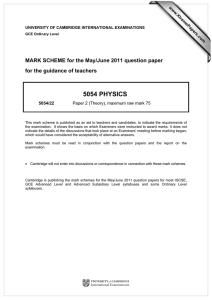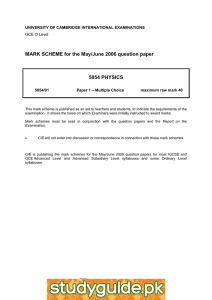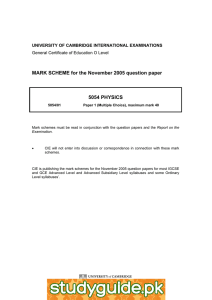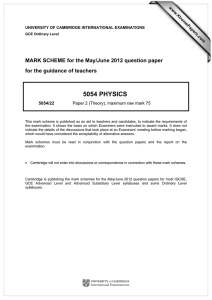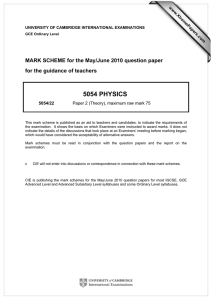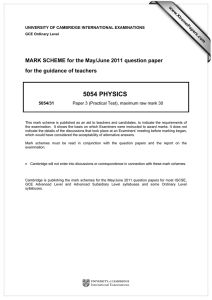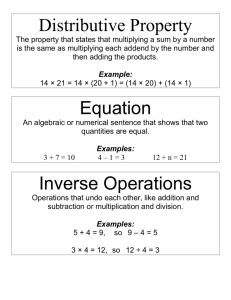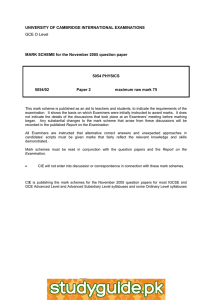5054 PHYSICS MARK SCHEME for the May/June 2013 series
advertisement
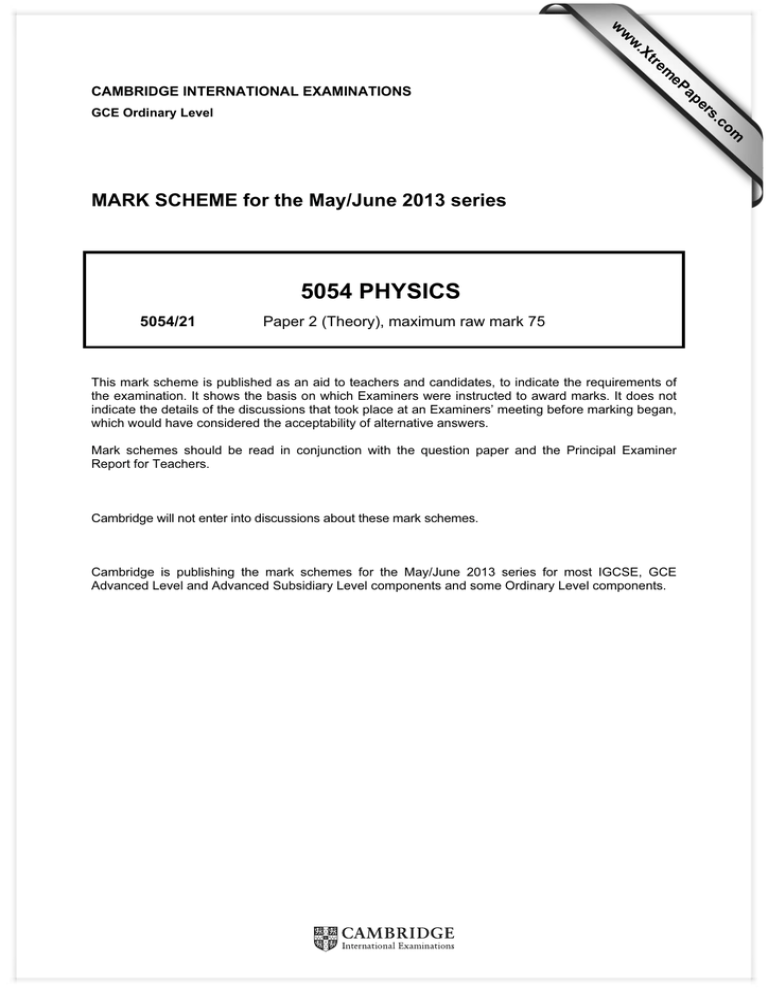
w w ap eP m e tr .X w CAMBRIDGE INTERNATIONAL EXAMINATIONS s er om .c GCE Ordinary Level MARK SCHEME for the May/June 2013 series 5054 PHYSICS 5054/21 Paper 2 (Theory), maximum raw mark 75 This mark scheme is published as an aid to teachers and candidates, to indicate the requirements of the examination. It shows the basis on which Examiners were instructed to award marks. It does not indicate the details of the discussions that took place at an Examiners’ meeting before marking began, which would have considered the acceptability of alternative answers. Mark schemes should be read in conjunction with the question paper and the Principal Examiner Report for Teachers. Cambridge will not enter into discussions about these mark schemes. Cambridge is publishing the mark schemes for the May/June 2013 series for most IGCSE, GCE Advanced Level and Advanced Subsidiary Level components and some Ordinary Level components. Page 2 Mark Scheme GCE O LEVEL – May/June 2013 Syllabus 5054 Paper 21 Section A 1 (a) 11 cm B1 (b) (graph is) a straight line/linear or has constant gradient or not curved B1 (c) (i) change in speed/velocity same change in uniform/same time or in 1 s M1 A1 (ii) 1. 2. 2 3 0.8 N B1 (a=) F/m algebraic or numerical e.g. F = ma; 0.8/0.2 (ecf 1. but not if F = 0) 4(.0) m/s2 C1 A1 (a) total/resultant moment zero or (sum of) clockwise = anticlockwise moment B1 (b) F1d1 or F2d2 seen in any form 8(.0) N C1 A1 (c) 4 + 1.2 or 5.2 seen 2.8 N ecf (b) i.e. accept 5.2 – (b) or (b) – 5.2 C1 A1 (a) Q and R B1 (b) ρgh in any form, algebraic or numerical 1.0(336) × 105 N/m2 C1 A1 (c) water is less dense or has density 1000 (kg/m3) B1 water further up tube/fills tube or height greater or water enters pump or water boils B1 4 (a) (i) 120 °C or –10 to 110 °C [5] [5] B1 (ii) same distance/length (on scale) for a temperature rise (along scale) or regular intervals/equal divisions (ign. numbers equally spaced) B1 (iii) diagram with any two markings further apart and none less B1 (b) resistance (of metal); e.m.f./voltage/current/p.d. (of thermocouple); pressure of gas; colour; quantity of radiation (ign. radiation) etc. B1 © Cambridge International Examinations 2013 [7] [4] Page 3 5 Mark Scheme GCE O LEVEL – May/June 2013 Syllabus 5054 (a) critical angle B1 (b) (i) light refracted out into air and bent away from normal (ignore reflected ray) B1 (ii) correct internal reflection (by eye) and no refracted ray (not at 90°) (c) (t =) distance/speed in any form numerical or algebraic (e.g. d/s, s/v 10/2 × 108) 2.5 × 10–10 s 6 Paper 21 B1 C1 A1 (a) current is directly proportional to voltage (accept voltage/current = constant, but not just = R) B1 if temperature/physical conditions constant B1 (b) (R=) V/I in any form algebraic or using any value of V and I from graph 20 Ω C1 A1 (c) (i) 40 Ω or 2 × (b) B1 (ii) straight line graph through origin below given line ecf (b) (e.g. accept above line if R < 20) M1 goes through 0.1 A at 4 V ecf (b) (e.g. allow through 0.2 A at 2 V if R = 10 Ω) A1 7 8 [5] (a) correct symbol for thermistor in series circuit with any power supply (e.g. cell or two circles) and a fixed resistor B1 B1 (b) (i) 12 (V) 0.018 (A) B1 B1 (ii) (P=) VI in any form algebraic or numerical with any voltage (4, 8 or 12) 0.14(4) W C1 A1 (iii) above maximum power or gets too hot or blows up or fails B1 (a) (soft) iron/mu-metal B1 (b) magnetic field or flux or flux/magnetic lines mentioned changing magnetic field or changing flux or flux lines cut coil induced voltage/current/e.m.f. B1 B1 B1 (c) less power/energy/heat loss (allow no power loss/to prevent power loss) or more efficient or thinner wire can be used (ign. cheaper) B1 [7] [7] [5] [Total: 45] © Cambridge International Examinations 2013 Page 4 Mark Scheme GCE O LEVEL – May/June 2013 Syllabus 5054 Paper 21 Section B 9 (a) (i) mass is the amount of matter/substance or to resist (change in) motion or (measurement of)inertia B1 weight is the pull/force of gravity or pull of Earth B1 accept mg where g stated as 10 (N/kg) or grav. field strength or acc. due to gravity ignore mg where g is gravity or grav. force or undefined (ii) mgh algebraic or numerical 1200 J C1 A1 (iii) ½ mv2 algebraic or numerical (speed =) 9/12 or 0.75 seen 5.6(25) J C1 A1 A1 (iv) (E=) VIt algebraic or numerical 4100 J or 4140 J C1 A1 (v) 1. B1 B1 2. energy can neither be created or destroyed/lost (but) may change form / be transferred electrical energy changes to P.E. (and K.E. and heat/work against friction; ign. mechanical energy) B1 [12] (b) (i) will not run out or infinite or being replaced (allow does not finish/always available) (ign. cannot be reused/recycled) B1 (ii) wind, tidal, solar/Sun, geothermal, hydroelectric, biomass, waves, wood (not nuclear) B2 (allow biogas/biofuel e.g. cane into petrol, dung into gas etc.) (ign. tidal waves) [3] [Total: 15] 10 (a) (i) (amount of) energy/work (by a device of power) 1 kW in 1 hr (ii) 80/1000 or 0.08 seen (e.g. 0.08 × 24 × 25) 168 or 24 × 7 (hours) seen (e.g. 0.08 × 24 × 7 × 25) 336 c or 340 c (accept $3.36 or any other e.g. £, R) (b) (i) mcT algebraic or numerical conversion of mass to g seen, e.g. 1500 used or shc used as 4200 1.6 × 105 J or 1.58 × 105 J or 157 500 J (allow 157(.5) J to score 2/3) (ii) (m=) E/L in any form numerical or algebraic e.g. 157 500/3.3 × 105 0.48 or 0.477 kg e.c.f. (i) © Cambridge International Examinations 2013 M1 A1 C1 C1 A1 C1 C1 A1 C1 A1 [5] Page 5 Mark Scheme GCE O LEVEL – May/June 2013 Syllabus 5054 Paper 21 (iii) 1. no fixed position/clusters/arranged randomly/close together/closely packed B1 move throughout/at random/slide past each other/not in an organised way B1 2. regular/orderly arrangement/crystal lattice or fixed position or close together (ign. evenly spaced) B1 vibrate B1 (iv) nothing/no change and increases B1 [10] [Total: 15] 11 (a) (i) 6 protons B1 8 neutrons B1 6 electrons outside nucleus or 6 electrons and protons & neutrons inside nucleus B1 (ii) different number of neutrons same number of protons (ignore electrons) (b) (i) 2 half lives seen e.g. 8 → 4 → 2 number of carbon atoms 2 × 1020 number of nitrogen atoms 6 × 1020 or (8 × 1020 – NC) atoms (ii) many half lives or has decayed (too much) or very few atoms (of C) left B1 B1 [5] C1 A1 B1 B1 [4] (c) (i) background count/rate taken without source B1 any count taken over any measured time e.g. 1 minute or any rate determined (allow read ratemeter) B1 take count/rate with aluminium between source and detector B1 at 5 mm count/rate goes to background/constant/zero when corrected for background B1 (ii) for protection (of the class/teacher e.g. to avoid cancer) or gamma-rays cannot pass through or to stop particles (hitting class/teacher) (ign. just “for safety”) B1 (iii) gamma-rays not stopped by/pass through (5–10 mm) aluminium B1 [6] [Total: 15] © Cambridge International Examinations 2013
